Assessing Benefits and Risks of Urban and Peri-Urban Agriculture (UPA): A Spatial Approach
Abstract
1. Introduction
2. Materials and Methods
2.1. The Study Area: Turin and Its Closest Municipalities
2.2. The Selected Core Set of Indicators: Criteria and Data Sources
3. Results
3.1. Spatial Configuration and Land Use
3.2. Urban Heat Island Effect
3.3. Participation Rate
3.4. Educational and/or Participatory Activities
3.5. Number of School Gardens
3.6. Recreational Value
3.7. Gentrification
3.8. Organic and Local Food
3.9. New Commercial Farms Created
4. Discussion and Conclusions
4.1. Applicability of the Initial Set of Indicators and Possible Future Research Outlines
4.2. Limits of Selected Indicators
4.3. Benefits and Risks of UPA: Findings and Recommendations for the Evaluation
4.4. The Potential Role of UPA in the Current and Upcoming Policy Framework
Funding
Institutional Review Board Statement
Informed Consent Statement
Data Availability Statement
Acknowledgments
Conflicts of Interest
Appendix A
| Category | Benefit | Indicator | Methodological References | Proxy Indicators | Scale of Application | Type of Indicator | Suggested Methods for Calculation and Data Collection | Require Data |
|---|---|---|---|---|---|---|---|---|
| Environment and climate | Increased quality and quantity of urban green spaces | Spatial configuration and land use | [12,22] | ̶ | TMA/City of Turin | State | participatory data collection, remote sensing, community mapping, land use analysis | land use and cover |
| Reduction in the urban heat island effect | Urban Heat Island effect | [12,18,23,24] | Spatial proximity UPA/UHI | City of Turin | State | meteorological temperature, measurement stations | temperature measurement | |
| Culture and society | Improvement of social cohesion and developing feelings of belonging and a sense-of-place | Participation rate | [11,15] | ̶ | City of Turin | State | participatory data collection, survey | number of people attending initiatives |
| Development of education and knowledge | Educational and/or participatory activities | [12,24] | n. of educational farms | TMA | State/change | participatory data collection, survey | number of activities | |
| Number of school gardens | [12,14] | ̶ | City of Turin | State | Survey, local dataset | number of initiatives | ||
| Improvement of leisure, recreation activities and tourist attractions | Recreational value | [12,22] | n. of recreational and tourism farms | TMA | State/change | Survey | Number of visitors and activities | |
| Neighborhood gentrification | Gentrification | [25] | land price, house values demographic trends | City of Turin | State | surveys, desk/document studies | Socio-demographic trends, land price and house values | |
| Food | Improvement of food quality | Organic and local food | [11] | n. of organic farms, local markets and on-site sell points | TMA | State/change | surveys, desk/document studies | Number and type of local and organic food |
| Economy | Improvement of local econmies | New professional farms created | [12,24] | n. of farms | TMA | State/change | surveys, desk/document studies | Number of farms |
References
- Cassatella, C.; Gottero, E. Type-Benefit Matrix, Including Set of Indicators, and Benefit Leaflets; H2020 Project n. 101000681, European Forum for a Comprehensive Vision on Urban Agriculture (EFUA), Deliverable D3.2. 2022. Available online: https://cordis.europa.eu/project/id/101000681/results (accessed on 28 April 2025).
- Lohrberg, F.; Lička, L.; Scazzosi, L.; Timpe, A. Urban Agriculture Europe; Jovis: Berlin, Germany, 2016. [Google Scholar]
- Provè, C. The Politics of Urban Agriculture. An International Exploration of Governance, Food Systems, and Environmental Justice. Ph.D. Thesis, Ghent University, Ghent, Belgium, 2018. [Google Scholar]
- Tapia, C.; Randall, L.; Wang, S.; Aguiar Borges, L. Monitoring the contribution of urban agriculture to urban sustainability: An indicator-based framework. Sustain. Cities Soc. 2021, 74, 103130. [Google Scholar] [CrossRef]
- Vásquez-Moreno, L.; Córdova, A. A conceptual framework to assess urban agriculture’s potential contributions to urban sustainability: An application to San Cristobal de Las Casas, Mexico. Int. J. Urban Sustain. Dev. 2013, 5, 200–224. [Google Scholar] [CrossRef]
- Pueyo-Ros, J.; Comas, J.; Corominas, L. Ediblecity: An R package to model and estimate the benefits of urban agriculture [version 2; peer review: 1 approved, 2 approved with reservations]. Open Res. Eur. 2023, 3, 112. [Google Scholar] [CrossRef]
- Langemeyer, J.; Madrid-Lopez, C.; Mendoza Beltran, A.; Villalba Mendez, G. Urban agriculture—A necessary pathway towards urban resilience and global sustainability? Landsc. Urban Plan. 2021, 210, 104055. [Google Scholar] [CrossRef]
- Artmann, M.; Sartison, K. The role of urban agriculture as a nature-based solution: A review for developing a systemic assessment framework. Sustainability 2018, 10, 1937. [Google Scholar] [CrossRef]
- Haberman, D.; Gillies, L.; Canter, A.; Rinner, V.; Pancrazi, L.; Martellozzo, F. The potential of urban agriculture in Montréal: A quantitative assessment. ISPRS Int. J. Geo-Inf. 2014, 3, 1101–1117. [Google Scholar] [CrossRef]
- Thiesen, T.; Bhat, M.G.; Liu, H.; Rovira, R. An Ecosystem Service Approach to Assessing Agro-Ecosystems in Urban Landscapes. Land 2022, 11, 469. [Google Scholar] [CrossRef]
- Eiter, S.; Fjellstad, W.; Metselaar, K.; Teixeira da Silva, R. Prioritised Indicators and Baseline. Edible Cities Network—Integrating Edible City Solutions for Social, Resilient and Sustainably Productive Cities. H2020 Project n. 776665, EdiCitNet, Deliverable D5.5. 2020. Available online: https://cordis.europa.eu/project/id/776665/results (accessed on 28 April 2025).
- Dumitru, A.; Wendling, L. Evaluating the Impact of Nature-Based Solutions: Appendix of Methods; Publications Office of the European Union: Luxembourg, 2021. [Google Scholar]
- Giacchè, G.; Consalès, J.-N.; Grard, B.-P.; Daniel, A.-C.; Chenu, C. Toward an evaluation of cultural ecosystem services delivered by urban micro-farms. Sustainability 2021, 13, 1716. [Google Scholar] [CrossRef]
- Gómez-Villarino, M.; Ruiz-Garcia, L. Adaptive design model for the integration of urban agriculture in the sustainable development of cities. A case study in northern Spain. Sustain. Cities Soc. 2021, 65, 102595. [Google Scholar] [CrossRef]
- Teitel-Payne, R.; Kuhns, J.; Nasr, J. Indicators for Urban Agriculture in Toronto: A Scoping Analysis; Toronto Urban Growers: Toronto, ON, Canada, 2016. [Google Scholar]
- Caputo, S.; Schoen, V.; Specht, K.; Grard, B.; Blythe, C.; Cohen, N.; Fox-Kämper, R.; Hawes, J.; Newell, J.; Poniży, L. Applying the food-energy-water nexus approach to urban agriculture: From FEW to FEWP (Food-Energy-Water-People). Urban For. Urban Green. 2021, 58, 126934. [Google Scholar] [CrossRef]
- Corbin, L.; Coudard, A.; Garmulewicz, A.; Powell, Z.; Singh, A.; Smith, C.; Bolumburu, P. Circular Principles and Indicators. H2020 Project n. 820937, REFLOW—Constructive Metabolic Processes for MateriaL Flows Inurban and Peri-Urban Environments across Europe, Deliverable 3.1. 2020. Available online: https://cordis.europa.eu/project/id/820937/results (accessed on 28 April 2025).
- Wendling, L.; Rinta-Hiiro, V.; Jermakka, J.; Fatima, Z.; Ascenso, A.; Miranda, A.; Roebeling, P.; Martins, R.; Mendonça, R. Performance and Impact Monitoring of Nature-Based Solutions. H2020 Project n. 730052, Unalab—D3.1 NBS Performance and Impact Monitoring Protocols. 2020. Available online: https://cordis.europa.eu/project/id/730052/results (accessed on 28 April 2025).
- Zasada, I.; Schmutz, U.; Wascher, D.; Kneafsey, M.; Corsi, S.; Mazzocchi, C.; Monaco, F.; Boyce, P.; Doernberg, A.; Sali, G.; et al. Food beyond the city—Analysing foodsheds and self-sufficiency for different food system scenarios in European metropolitan regions. City Cult. Soc. 2019, 16, 25–35. [Google Scholar] [CrossRef]
- Gottero, E.; Cassatella, C. Spatial Tools to Renew the Planning Paradigm Through Metropolitan Agriculture. The Case Study of Turin (Italy). In Agrourbanism. Tools for Governance and Planning of Agrarian Landscape; Gottero, E., Ed.; Springer: Cham, Switzerland, 2019; Volume 124, pp. 241–258. [Google Scholar]
- Kemp, D. The Environment Dictionary; Routledge: London, UK, 1998. [Google Scholar]
- Connop, S.; Nash, C.; Elliot, J.; Haase, D.; Dushkova, D. Nature-Based Solution Evaluation Indicators: Environmental Indicators Review. Horizon 2020 Project n. 730222, Connecting Nature. 2020. Available online: https://connectingnature.eu/nature-based-solution-evaluation-indicators-environmental-indicators-review (accessed on 28 April 2025).
- Song, Y.; Gil, J.; Wandl, A.; Timmeren, A.V. Evaluating sustainable urban development using urban metabolism indicators in urban design. Eur. XXI 2018, 34, 5–22. [Google Scholar] [CrossRef]
- Urban GreenUP, D5.3: City Diagnosis and Monitoring Procedures. Horizon 2020 Project n. 730426, URBAN GreenUP—New Strategy for Re-Naturing Cities through Nature-Based Solutions. 2019. Available online: https://cordis.europa.eu/project/id/730426/results (accessed on 28 April 2025).
- Nature4Cities. D2.1—System of Integrated Multi-Scale and Multithematic Performance Indicators for the Assessment of Urban Challenges and NBS, Horizon 2020 Project n. 730468, Nature4Cities—Nature Based Solutions for Re-Naturing Cities: Knowledge diffusion and Decision Support Platform Through New Collaborative Models. 2017. Available online: https://cordis.europa.eu/project/id/730468/results (accessed on 28 April 2025).
- City of Turin. Atlante Degli Orti Urbani—Allegato 2 del Piano Strategico Dell’infrastruttura Verde [Atlas of Urban Gardens—Annex 2 of the Green Infrastructure Strategic Plan]. 2019. Available online: https://servizi.comune.torino.it/consiglio/prg/documenti1/atti/allegati/202002957_1_2bis.pdf (accessed on 26 April 2024).
- City of Turin. Torino Food Metrics Report 2022; Università di Torino: Torino, Italy, 2022. [Google Scholar]
- John, H.; Artmann, M. Introducing an integrative evaluation framework for assessing the sustainability of different types of urban agriculture. Int. J. Urban Sustain. Dev. 2024, 16, 35–52. [Google Scholar] [CrossRef]
- Cassatella, C.; Gottero, E. Integrating urban and peri-urban agriculture in planning systems. Barriers, policy tools and recommendations. Plan. Pract. Res. 2025, 1–34. [Google Scholar] [CrossRef]
- Marino, D.; Curcio, F.; Felici, F.B.; Mazzocchi, G. Toward Evidence-Based Local Food Policy: An Agroecological Assessment of Urban Agriculture in Rome. Land 2024, 13, 30. [Google Scholar] [CrossRef]
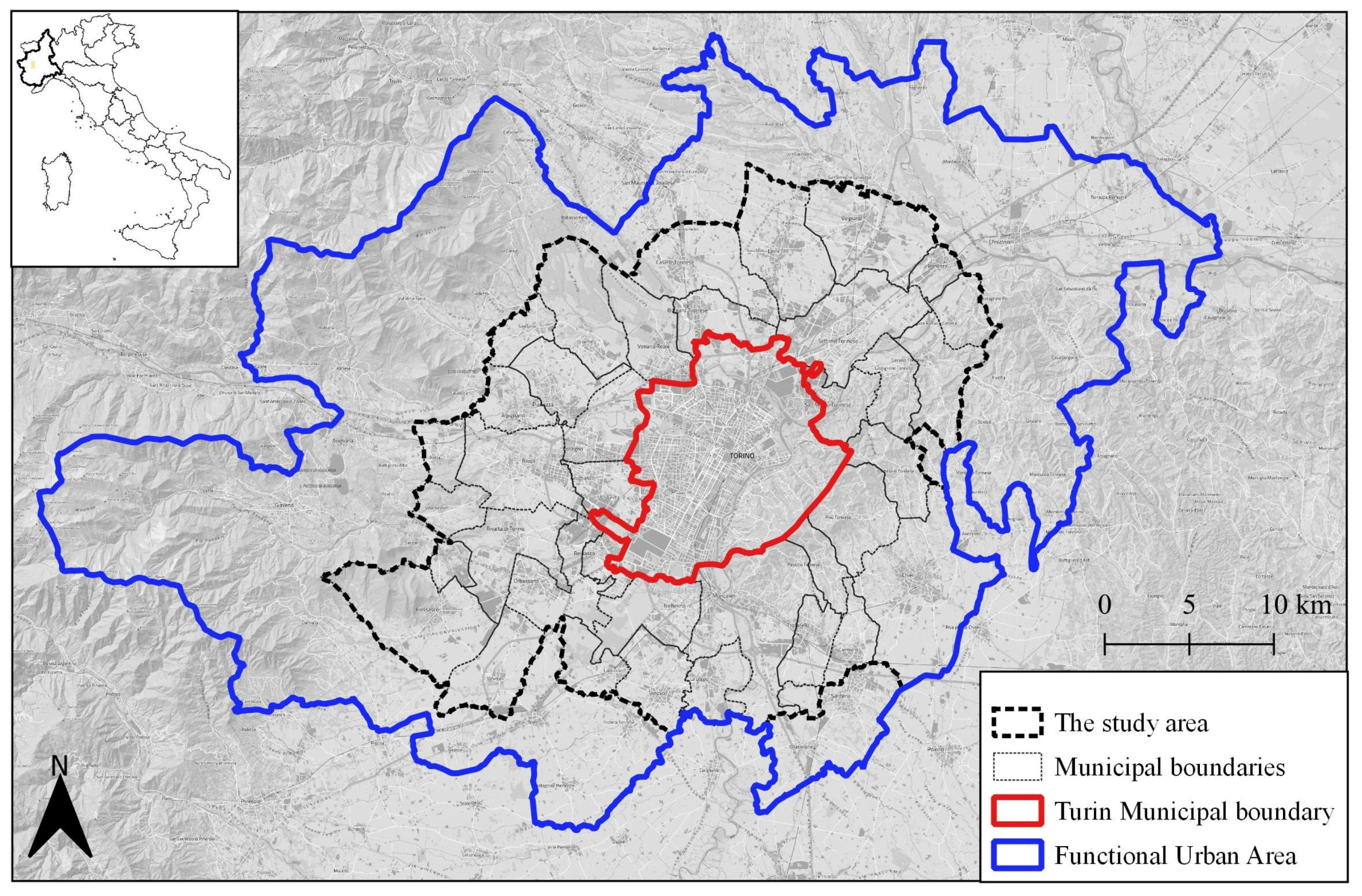

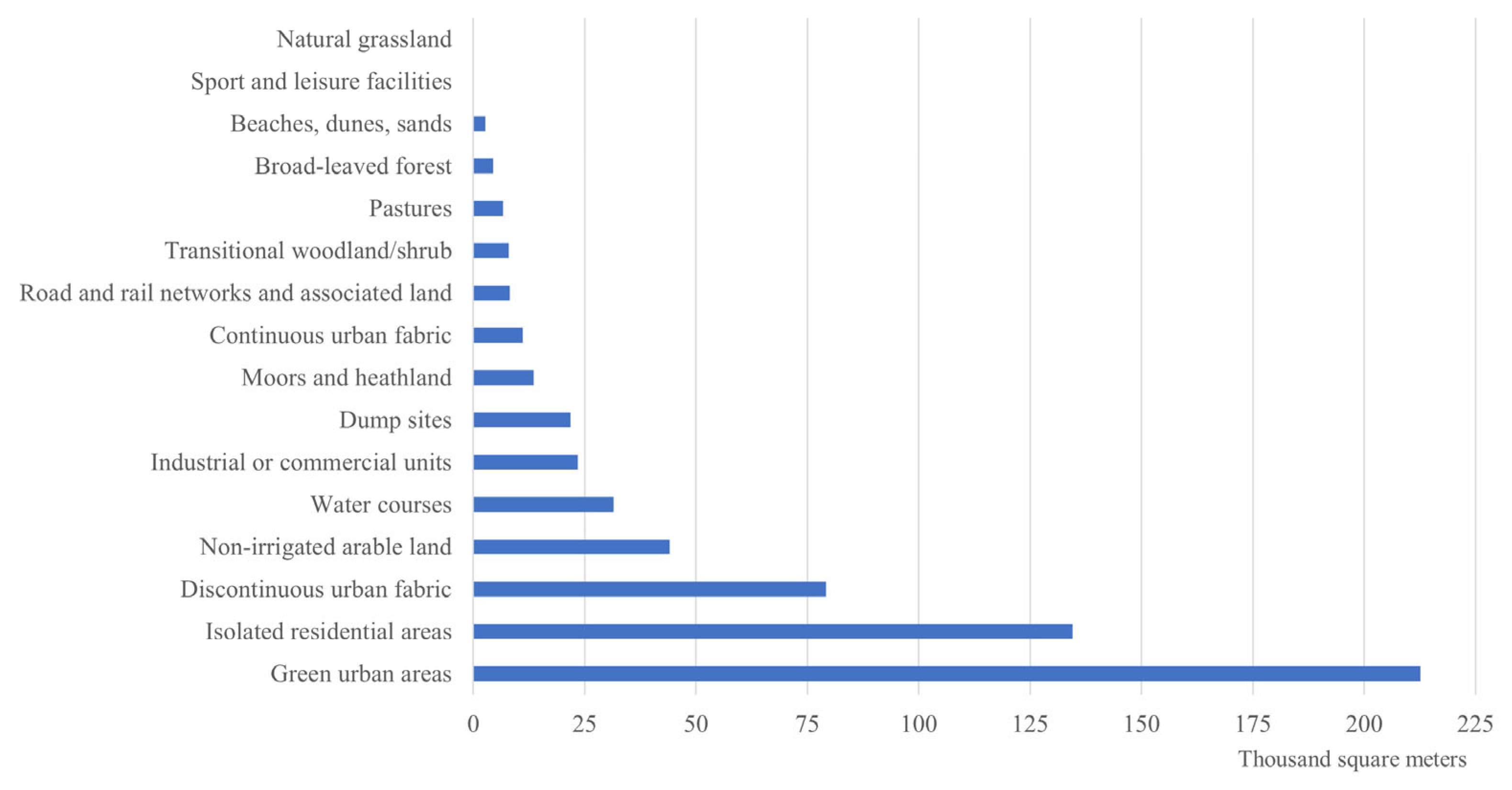



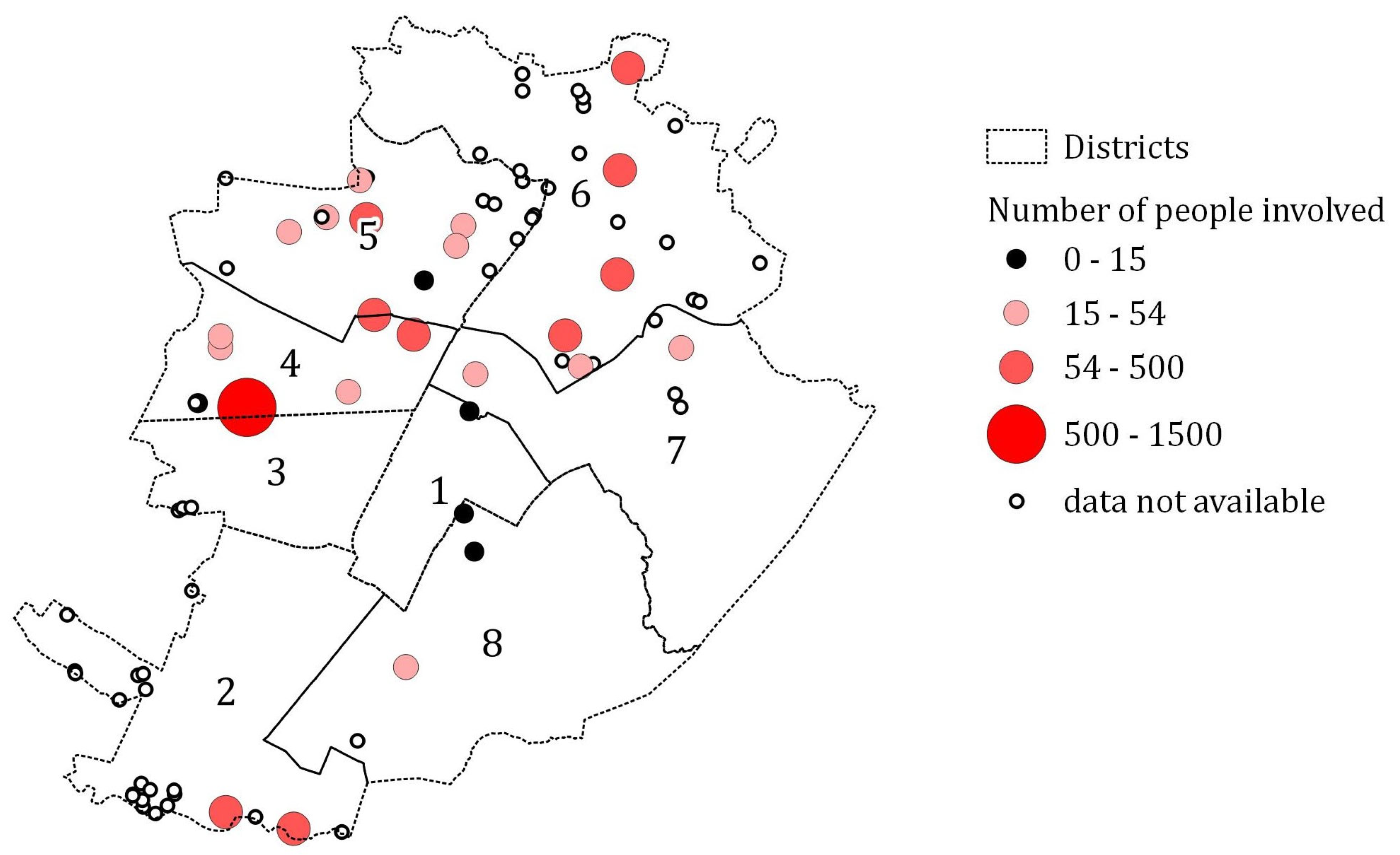
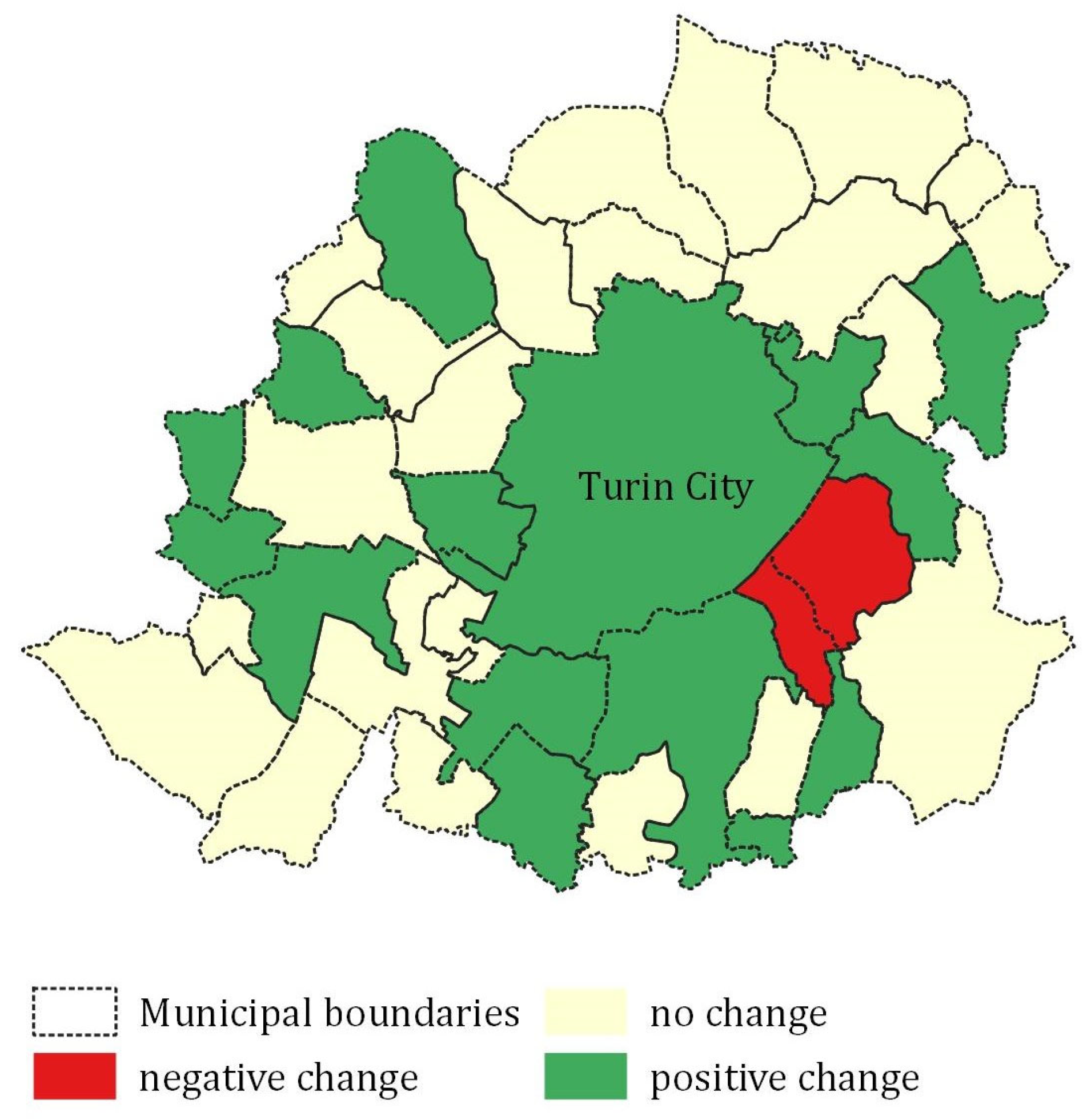


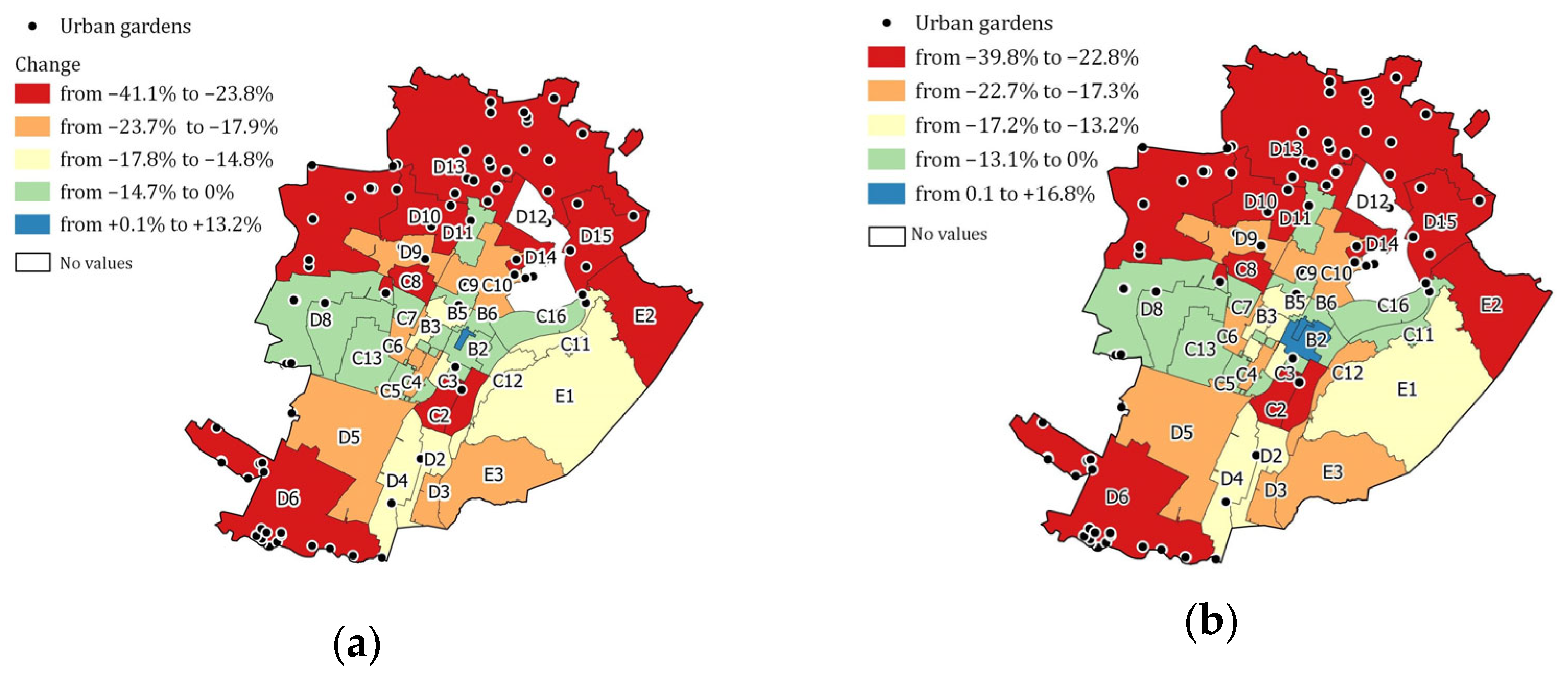
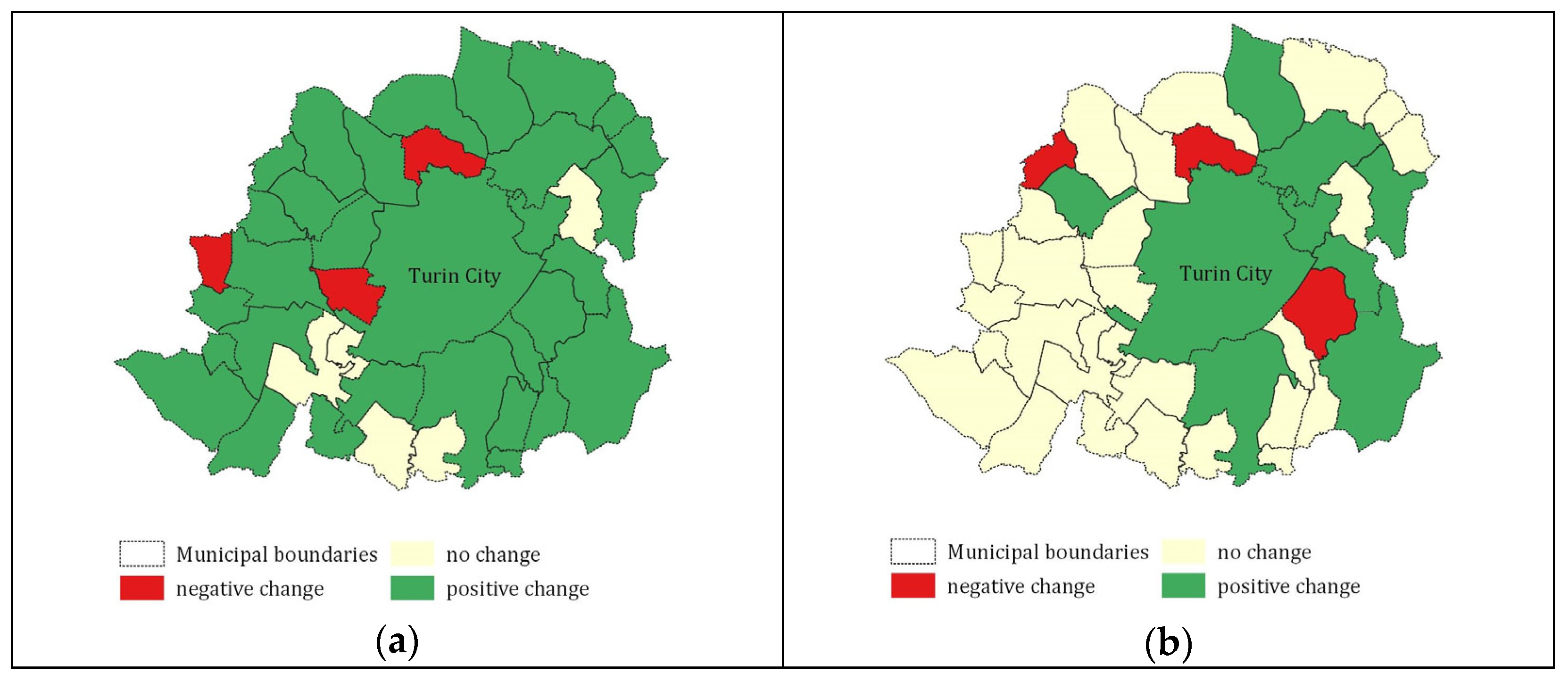
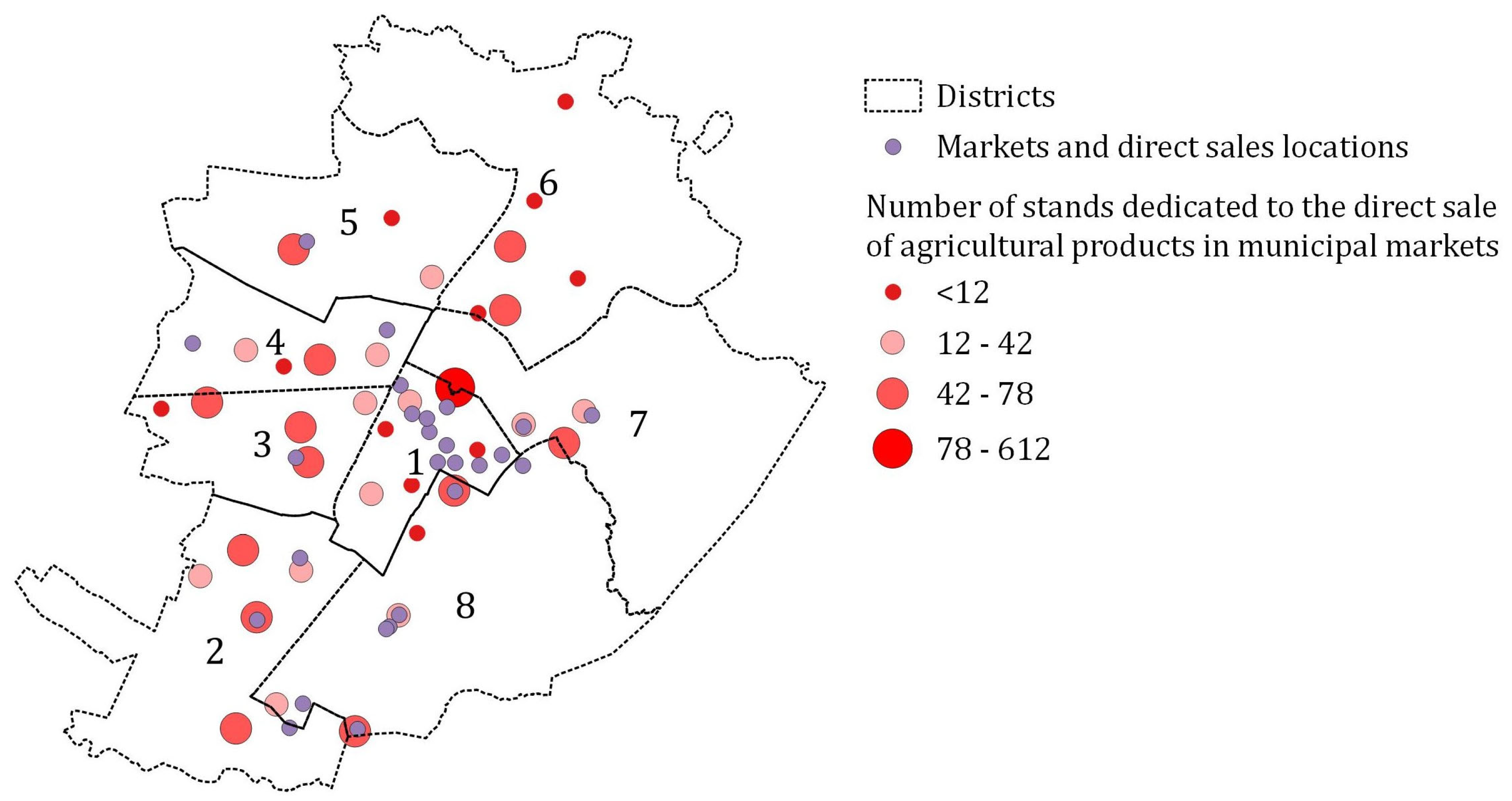

| Category | Benefit or Risk | Indicator | References | Proxy Indicators |
|---|---|---|---|---|
| Environment and climate | Increased quality and quantity of urban green spaces | Spatial configuration and land use | [12,22] | ̶ |
| Reduction in the urban heat island effect | Urban Heat Island effect | [12,18,23,24] | Spatial proximity UPA/UHI | |
| Culture and society | Improvement of social cohesion and developing feelings of belonging and a sense of place | Participation rate | [11,15] | ̶ |
| Development of education and knowledge | Educational and/or participatory activities | [12,24] | n. of educational farms | |
| Number of school gardens | [12,14] | ̶ | ||
| Improvement of leisure, recreation activities and tourist attractions | Recreational value | [12,22] | n. of recreational and tourism farms | |
| Neighborhood gentrification | Gentrification | [25] | land price, house values demographic trends | |
| Food | Improvement of food quality | Organic and local food | [11] | n. of organic farms, local markets and on-site sell points |
| Economy | Improvement of local economies | New commercial farms created | [12,24] | n. of farms |
| Indicator or Proxy Indicator | Data | Producer (Year) |
|---|---|---|
| Spatial configuration and land use | Land cover and use | Piedmont Region authority (2021) |
| Urban garden spatial configurations | [20] | |
| Zoning | Turin Metropolitan Authority (TMA)—Mosaic of urban plans (2021) | |
| Urban Heat Island effect | UHI Index | [26] |
| Participation rate | n. of people involved | [26] |
| Educational and/or participatory activities | n. of educational farms | Piedmont Region authority—AAU register (2015 and 2019) |
| Number of school gardens | n. of school gardens | [26] |
| Recreational value | n. of recreational and tourism farms (agriturismi) | Piedmont Region authority—AAU register (2014 and 2022) |
| Gentrification | land price | Agenzia Entrate—OMI (2013 and 2023) |
| house values | Agenzia Entrate—OMI (2013 and 2023) | |
| demographic trends | ISTAT (2011 and 2021) | |
| Organic and local food | Organic farms, farm on-site sell points | Piedmont Region authority—AAU register (2016 and 2022) |
| Local market | [27]; Campagna Amica Register (2016) | |
| New commercial farms created | n. of farms | Piedmont Region authority—AAU register (2015 and 2023) |
| District | Name | n. Urban Gardens | n. People Involved | People/Garden |
|---|---|---|---|---|
| 1 | Centro-Crocetta | 1 | 12 | 12.0 |
| 2 | Santa Rita-Mirafiori | 22 | 602 | 27.4 |
| 3 | San Paolo-Cenisia-Pozzo Strada-Cit Turin-Borgata Lesna | 3 | n.d. | n.d. |
| 4 | San Donato-Campidoglio-Parella | 7 | 1702 | 243.1 |
| 5 | Borgo Vittoria-Madonna di Campagna-Lucento-Vallette | 19 | 294 | 15.5 |
| 6 | Barriera di Milano-Regio Parco-Barca-Bertolla-Falchera-Rebaudengo-Villaretto | 22 | 521 | 23.7 |
| 7 | Aurora, Vanchiglia-Sassi-Madonna del Pilone | 5 | 84 | 16.8 |
| 8 | San Salvario-Cavoretto-Borgo Po-Nizza Millefonti-Lingotto-Filadelfia | 4 | 37 | 9.3 |
| Total | 83 | 3252 | 39.2 | |
| Total Change | Total Change (Except Turin) | Percentage over TMA (2023) | |
|---|---|---|---|
| Organic farms (2015–2023) | +59.6 | +62.6 | 12.3% |
| UAA BIO (2016–2022) | +218.3 | +236.3 | 3.4% |
| Farms with on-site sale (2015–2023) | +33.3 | +22.2 | 1.2% |
| Category | Indicator | Proxy Indicators | Measured Benefit | Applicability | Recommendations |
|---|---|---|---|---|---|
| Environment and climate | Spatial configuration and land use | ̶ |  | medium | Collect spatial data and temporal land use change at UPA project/initiative level |
| Urban Heat Island effect | Spatial proximity UPA/UHI |  | hard |
| |
| Culture and society | Participation rate | ̶ | easy | Conduct periodic monitoring of single initiatives | |
| Educational and/or participatory activities | n. of educational farms |  | medium | Conduct periodic monitoring of single initiatives, especially for non-profit practices | |
| Number of school gardens | ̶ |  | medium | Conduct periodic monitoring of single initiatives | |
| Recreational value | n. of agriturismo |  | medium | Conduct periodic monitoring of the number of visitors and activities in the profit and non-profit initiatives | |
| Gentrification | land price, house values, demographic trends |  | hard | Collect spatial data on socio-demographic trends, land price and house values at district level | |
| Food | Organic and local food | n. of organic farms, local markets and on-site sell points |  | medium |
|
| Economy | New commercial farms created | n. of farms |  | easy |
|
 : Positive change;
: Positive change;  : Negative change;
: Negative change;  : Undefined or null change.
: Undefined or null change.Disclaimer/Publisher’s Note: The statements, opinions and data contained in all publications are solely those of the individual author(s) and contributor(s) and not of MDPI and/or the editor(s). MDPI and/or the editor(s) disclaim responsibility for any injury to people or property resulting from any ideas, methods, instructions or products referred to in the content. |
© 2025 by the author. Licensee MDPI, Basel, Switzerland. This article is an open access article distributed under the terms and conditions of the Creative Commons Attribution (CC BY) license (https://creativecommons.org/licenses/by/4.0/).
Share and Cite
Gottero, E. Assessing Benefits and Risks of Urban and Peri-Urban Agriculture (UPA): A Spatial Approach. Sustainability 2025, 17, 5151. https://doi.org/10.3390/su17115151
Gottero E. Assessing Benefits and Risks of Urban and Peri-Urban Agriculture (UPA): A Spatial Approach. Sustainability. 2025; 17(11):5151. https://doi.org/10.3390/su17115151
Chicago/Turabian StyleGottero, Enrico. 2025. "Assessing Benefits and Risks of Urban and Peri-Urban Agriculture (UPA): A Spatial Approach" Sustainability 17, no. 11: 5151. https://doi.org/10.3390/su17115151
APA StyleGottero, E. (2025). Assessing Benefits and Risks of Urban and Peri-Urban Agriculture (UPA): A Spatial Approach. Sustainability, 17(11), 5151. https://doi.org/10.3390/su17115151






